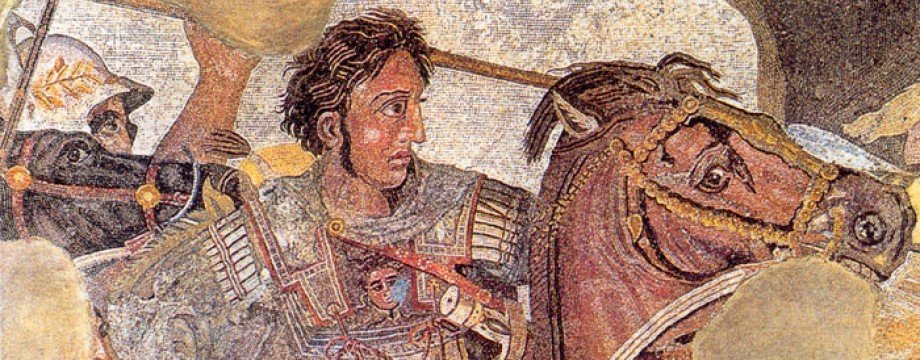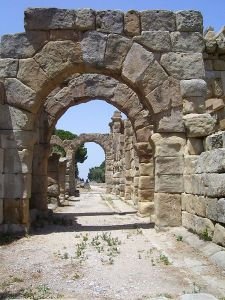Daily Diodorus
Vol. VIII. Book XVII Ch. 95, 96 (Loeb Classical Library)
Read the other posts in this series here
The Headlines
Great Camp Assembled: A Different Kind of Shock and Awe
Congratulations to Bucephala and Nicaea on their Name Day
* Inside: Remembering the horse behind the name
Sibians: A Present People, A Past Legend
The Story
Once the decision to return west had been taken, Alexander didn’t simply up sticks and depart. On the banks of the Hyphasis River he had his men construct altars to the dodekathaeon, fifty cubits (75 feet) high.
A camp perimeter was ‘traced’ at three times its normal size and a ditch ‘fifty feet wide and forty deep’ created. The displaced earth was used to make a great wall.
Inside the ‘camp’, men were ordered to build outsized beds and stables that were ‘twice the normal size’. Alexander wanted any natives passing this way to believe that ‘men of huge stature, displaying the strength of giants’ had once been here.
Only when the entire camp had been built in similarly exaggerated proportions did Alexander finally take his leave of the easternmost border of his empire.
From the Hyphasis, the Macedonian king returned to the Acesines River. There, he found the ships he had ordered to be built (see Chapter 89) ready and waiting for him.
But rather than board them and set sail straightaway, Alexander again paused. The ships needed to be fitted out and he wanted more built.
It was while the ships were being attended to and built that reinforcements arrived all the way from Greece. They comprised of Greek allied soldiers and mercenaries. In total they were 30,000 infantry and just under 6,000 cavalry. The soldiers came with ‘elegant suits of armour for 25,000 foot soldiers and a hundred talents of medical supplies’.
The armour and supplies were distributed to the men. By the time this was done, the fleet was again ready. It now comprised of ‘two hundred open galleys and eight hundred service ships’.
Alexander’s last act before finally setting sail was to name the two cities he had built on either side of the river. These became Nicaea on the western side and Bucephala on the eastern bank, where the battle against Porus had been fought.
Before I continue, I must pause to address two slightly confusing matters that you may have noticed.
i. I don’t know if it comes out as such, but when I wrote about the building of Nicaea and Bucephala in this post I did so under the impression that both cities were built on the eastern side of the river - Bucephala on the eastern bank and Nicaea further on. That this was the case was the impression I got from Diodorus’ text where he writes, ‘[Alexander] founded two cities, one beyond the river where he had crossed and the other on the spot where he had defeated Porus’. He now states that the cities were built ‘on either side of the river’.
ii. When Diodorus has Alexander name Nicaea and Bucephala he is still on the Acesines River. However, in Chapter 89 they are being built on (either side of) the Hydaspes. The Footnotes state that the Hydaspes is renamed the Acesines ‘after its confluence with the Sandabal and the Hyarotis’. If this is the case, Diodorus has been a bit lazy in saying the battle happened on the Hydaspes but at least it clears up the confusion… except that in Chapter 96, he ‘mentions the confluence of the Acesines and Hydaspes as if they were different’. The Footnotes suggest that the Acesines is the Sandabal river.
Chapter 96
Alexander now set sail. The fleet was not large enough to carry the entire army, or even most of it; led by Craterus and Hephaestion, they marched down river. The Footnotes cite Arrian as saying Craterus marched on the right bank and Hephaestion on the left. Given their prickly relationship that was probably just as well.
At ‘the junction of the Acesines and the Hydaspes’ (see point ii above), Alexander disembarked and led his army ‘against the people called the Sibians’. Diodorus refers to the belief that they ‘are the descendants of the soldiers who came with Heracles to the rock of Aornus’ and ‘were settled in this spot by him’. It isn’t made clear whether Alexander knew this or not before he stepped off his ship.
Either way, no fighting happened. The ‘leading notables’ of the Sibians met him and handed over ‘magnificent gifts’. They ‘renewed their ties of kinship, and undertook to help him enthusiastically in every way, as being his relatives’. Alexander gave the Sibians their freedom and moved on.
The Agalesseis came next. Their army - 40,000 infantry and 3,000 cavalry - formed up against the Macedonians. In the ensuing battle, Alexander killed most of the enemy. Some Agalesseians escaped from the carnage into ‘neighbouring cities’. These were put under siege and captured. Prisoners were sold as slaves.
Alexander also stormed ‘a large city in which twenty thousand persons had taken refuge’. There, his army appears to have sustained high losses in the street-by-street fighting. Angered by this, Alexander torched the city, burning most of the city’s inhabitants to death in the process. This sounds a very ugly moment. The Footnote, however, record Curtius as saying that the Indians themselves set fire to the city ‘to avoid subjection’.
The surviving Agalesseians withdrew to the city’s citadel. There, they ‘appealed for mercy with suppliant branches’. Despite his anger, or perhaps now becalmed, Alexander accepted their appeal.
Comments
Alexander’s building of a super-sized camp reminds me of the Anglo-Saxons’ reaction to the ruined Roman villas. They too thought they had been built by giants.
I wonder what the new arrivals from Greece felt like when they finally reached Alexander only to discover that they were going back the way they came again! Annoyed or quite happy?
When Arrian says that Craterus marched on the right bank and Hephaestion on the left I assume this is as you look down the river towards the Ocean; if so, Craterus would have been on the western bank and Hephaestion on the eastern.
Giants, Mind Your Heads

